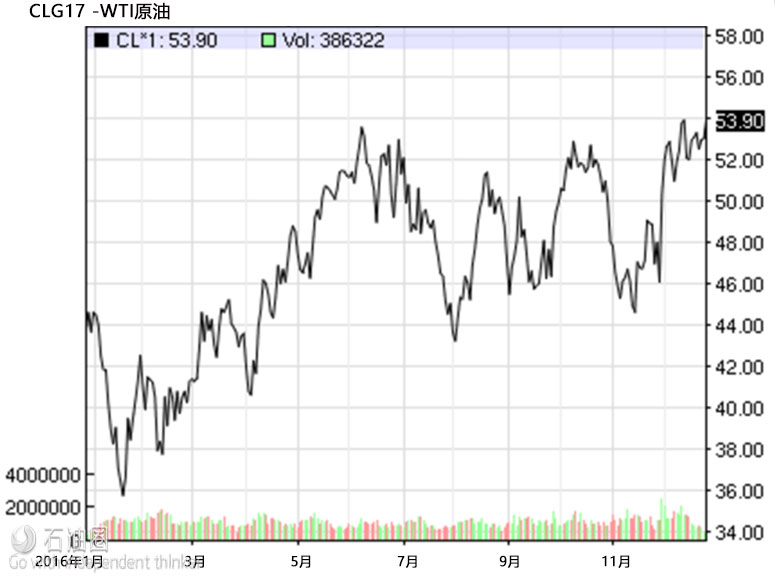If you’ve been following Oilpro for the last year, you’ve probably already seen much of what I’m going to post. If you haven’t been following it, then here’s a simple refresher of some of the things we read and talk about on this site.
Oil Price Predictions
Everyone was concerned with the price of oil for at least the last two years. Around the middle of March, Mike Hardy posted a question concerning the price of oil at the end of the year.
There were 79 answers, in addition to many comments on those answers, so without a precise accounting, I will say there are at least 100 predictions of the price of oil at the end of this year.
Right now, the price is around $54 dollars. The consensus on the March thread was “$50 to $55” from a plurality of the respondents. If things don’t change greatly in the next two days, then I’d say that Oilpro has actual oil pros, at least when it comes to the direction of oil prices.
For the record, my suggestion – which hasn’t changed in about 2 years – is $40 to $70 and probably somewhere near the middle of that, with a stab at a precise “$51.30” for the linked question. It looks like I’ll be a little low. I am happy to be off on the low side. It is much better than prices dropping again.
Looking at the chart above, everyone can see that oil prices overall have improved in 2016. From about $45 on average for most of 2015, 2016 improved to average slightly below $50 for the year. That’s about a 10 percent increase, year on year, so it’s at least ahead of inflation. That’s nowhere near the anomalous $100s of earlier in this decade, but it’s still a reasonable level for oil, as long as it continues the trend of improvement we’ve been seeing all year.
The graph above shows the rig count worldwide, taken from Baker Hughes data and graphed in Excel. All I’ve done is group Dec 2015 through the latest data (Roughly Dec 1, 2016) and then asked Excel to do a simple line graph.
The chart shows some bad news and some good news. The bad news is that the rig count internationally is down from last year by about 370 rigs (2047 in Nov of 2015, not shown on this chart, down to 1678 at the end of Nov 2016). The good news is that there is about a six-month trend of rig counts increasing.
When rig count was down, John Lewis posted his prediction that we were going to hit an all-time low in 2016. If he is correct, then we hit the bottom about three months after his prediction in April with a weekly count of 408, as shown in the chart below.
Joseph Triepke chimed in with an article which needs to have its title repeated: Last Time US Rig Count was this Low, Abraham Lincoln was President.
How did Oilpro react to the news? I’ve said before that being in the oil patch means you are an optimist by default. You have to always think the best, or you’ll be continuously depressed. The responses proved this was true.
When rig counts were down, many Oilpros chimed in with comments such as Larry Albert saying, “The deeper the decline the higher the rebound. This downturn will eventually result in a shortage of petroleum and much higher prices.”
Oilpro’s Joseph Triepke called the bottom within two weeks with the post The Worst US Drilling Drops For 2016 Have Now Passed. The charts aren’t quite clear enough to say whether he was “spot on,” or just “really close,” but it’s undeniable that he called the bottom right about the time the bottom hit.
What was the reaction? Shawn Duffy said, “At some point the old-school wildcatter independents should be saying, ‘Shucks, day rates are so low I should hire a rig and drill because the price goes up sooner or later!’ Maybe we are getting to that point?”
And when oil rig counts went up? Well, even our perpetually dour James Drouin chimed in with, “‘U.S. Oil Rig Count Continues to Rise’ A dozen or more so weeks like this and I’m gonna have to be a “glass half full” kind of person!!!”
Bankruptcies
2015 and 2016 have to be known for the number of bankruptcies, especially in the LTO plays of the US. I won’t do a count, but it has to be at least 400 companies. There were two continual refrains from Oilpro denizens, which can be summed up in the following two quotes:
“Those who are in power, stay in power and lose nothing.”
Exemplar: Jackie Gillispie: “Did even one of those ex board members lose as much as one dollar? Probably not. Did any of those bond companies lose any money? Probably not. Curtis can tell you who lost money. Their field hands that lost their jobs and the vendors they owed money to. We have seen this movie many times out here in the field. Yeah. Pretty sure we know how bankruptcy works.”
“How can they go bankrupt but remain in business?”
Exemplar: Mike Black: “Bankruptcy in the states is a big joke. Just means that you write off your debt and continue borrowing more money.”
OPEC and the Kingdom of Saudi Arabia
The two entities above are often conflated on Oilpro. Sometimes when talking about OPEC, “Saudi Arabia” is mentioned, and sometimes it is the reverse.
This is one of the few areas where Oilpros are at odds. There are two distinct camps: One camp blames OPEC/KSA for the international oil woes; the other blames LTO/US “Drill, baby! Drill!” for the present predicament. I’ll go on record (and have done so many times) as stating I’m in the second camp, but that’s not the point of this section.
For much of the last year, there has been continual speculation that OPEC/KSA would cut their production because they needed the money. Eventually, the prediction that they would cut production – or at least announced a plan to cut production – came true at the meeting on November 30 of this year. The Saudis’ plan to force out their competition resulted in a decrease in U.S. LTO production of roughly 1 million barrels per day, but not much else happened due to OPEC’s increase from a reported 30 million BPD to 33+ million BPD over the two year period between their Nov 2014 “market share” announcement to the Nov 2016 “stabilize oil prices” announcement.
There are many quotes on both sides of the argument above, but I won’t link to any, as they all basically rehash the same arguments. They can be summed up as “This crash is (KSA or LTO)’s fault.” The crash happened because we were all producing more oil than was being consumed, so everyone producing oil was at least partially at fault.
Wars
There is no doubt that oil is an international commodity. There are many wars going on right now, with the term “proxy war” being used by quite a few people. Right now, KSA and Iran are involved in one war proclaimed to be such in Yemen. Although I’m pretty sure that the Yemenis are thinking that the war is local, most of the pundits say it is actually KSA and Iran fighting each other by proxy.
The war in Syria is showing signs of slowing down. Russia has made some announcements just today about drawing down its forces in the area.
Libya and Iraq both have cities held by Daesh. Sirte in Libya is “smack dab in the middle” between the two power bases of that country, Tripoli and Benghazi. I’m not certain they still hold it, but the last I heard, Daesh was in control of that city. In Iraq, Mosul is currently the fight in progress, with a great likelihood that the Mosul Dam might be breached intentionally by the nutcases who are holding out against combined forces spear-headed by the Kurds.
We also have Boko Haram and the purported Niger Delta Avengers in Nigeria. Boko Haram appears to be a terrorist group with a religious cause, but the Niger Delta Avengers are specifically targeting the oil system in the Niger Delta region.
What all of the conflicts mentioned above have in common are that they all involve oil-producing and exporting countries. What have the Oilpros been saying about these conflicts?
Charles Yeiser, commenting on the Nigeria situation: “I applaud the President’s initiative to tackle the long entrenched corruption in the country and the Oil and Gas industry. I also have no doubt that much if not all the ‘avenger’ trouble are orchestrated by the corrupt parties to obstruct his efforts. It’s not an easy task, nor is his pledge to end insurgency and to come down hard on Boko Haram but for the future of Nigeria and its people, those things are a priority.”
Nigel Davis, commenting on the Yemeni proxy war: “The Proxy war for the Yemen is more important than is usually given credence. If Iran can control the Yemen, but more importantly the port of Aden, it will then have a stranglehold on both the Straits of Hormuz through which the majority of the Gulf’s oil is exported and also the Strait of Bab al-Mandra which is the choke point on the entrance to the Red Sea and the Suez Canal.”
Back in May of this year, it was humble (OK, not so humble) me who said, “Libya can’t decide who is and who is not in charge. Even their ‘recognized’ government is infighting, and some of the most organized areas are run by unrecognized opposition. Throw in ISIS in Sirte and trying to expand, and things don’t look good for any production rise from Libya on the horizon.”
Conclusion
The pros on Oilpro have time and again this year proven that they deserve that moniker, and the proof is shown every day in the articles and the comments.


 石油圈
石油圈

